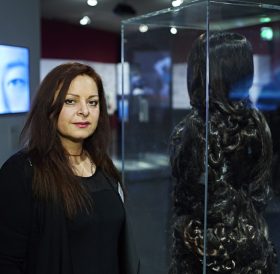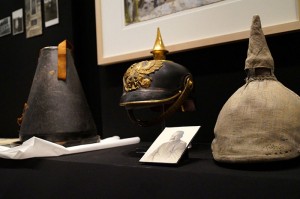Of Persian fairy tales and female self-determination

Artist Mandana Moghaddam standing next to her sculpture Chelgis I in the exhibition Cherchez la femme. Wig, Burqa, Wimple; Jewish Museum Berlin, photo: Yves Sucksdorff
In the course of the new exhibition Cherchez la femme – which deals with the covering of women within the idea of the monotheism of the three leading religions – we spoke with Iranian artist Mandana Moghaddam. Her artwork Chelgis (pronounced “Gelgis”) contributes to the concept of the exhibition in an impressive way and further stimulates the viewers’ own contemplation on the subject. Just in time for the exhibition’s opening we conducted a short interview with Mandana Moghaddam:
Dear Ms. Moghaddam, would you tell us a little bit about your artwork and the story of Chelgis?
I began my work by thinking of contemporary womens’ issues, examining them from different angles. When I drew the first sketch I saw the story of Chelgis – which means “40 braids” – right in front of me. → continue reading
Or: How 300 Artifacts from our Collection Were Turned into a Cabinet Exhibition about the First World War

Objects from our collections in the exhibition “The First World War in Jewish Memory”
© Jewish Museum Berlin, photo: Mariette Franz
Our exhibition “The First World War in Jewish Memory” opened last week. It is based primarily on collections donated to the Jewish Museum by German-Jewish families and each exhibit tells a very personal story.
In total, 176 exhibits were selected, researched and arranged as a visual narrative by eight curators, six restorers, two exhibition technicians, a translator and a graphic artist. So, even before I mention our numerous willing helpers in the wings, in particular the student assistants and the Museum caretaker, this sounds like a big team for a big exhibition. In fact, our joint endeavor culminated in a small cabinet exhibition relating to the First World War, which can be viewed until 16 November in the Rafael Roth Learning Center. → continue reading
– a Youth Spent in Iran and Vienna
This week, from 21 to 27 October 2013, the Academy of the Jewish Museum Berlin, in cooperation with Kulturkind e.V., will host readings, workshops, and an open day for the public with the theme “Multifaceted: a book week on diversity in children’s and youth literature.” Employees of various departments have been vigorously reading, discussing, and preparing a selection of books for the occasion. Some of these books have already been introduced here over the course of the last months.

In her autobiographical graphic novel Persepolis, the author Marjane Satrapi, born in 1969, portrays the history of her native Iran as well as that of her own family. The two are closely interwoven. Marjane grew up in Iran during a time of upheaval: when she was ten, the Shah was overthrown and people danced in the streets. But the feeling of liberation was brief. Soon the new religious regime began to enforce its ideas of morality and decency. It forbade alcohol and Western music, insisted that even non-religious women wear the veil, and put opponents into prison or had them assassinated. Marjane’s open-minded, liberal parents are understanding and give her space and freedom. But she finds it difficult to adjust to the rules outside their home. She rebels against the dress codes, goes to parties, and argues with her teachers. → continue reading


